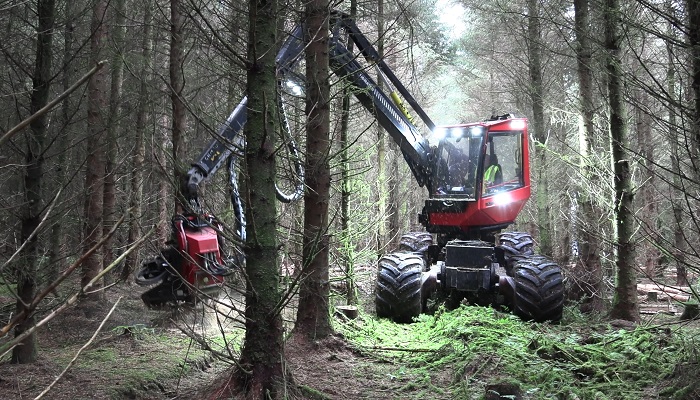25 March 2022
Forestry Health and Safety

It is the responsibility of every forest owner to make their forest a safe and healthy place to work. Steven Meyen, Teagasc Forestry Development Officer has key advice on Health and Safety in the forestry sector. Learn about your role as a Landowner, Forestry Works Manager, Contractor or other party
Above photo: Appropriate hazard signs are a useful tool to make a timber harvesting site safer. Photo: Teagasc.
Health and safety
With the damage that storms Barra, Dudley, Eunice and Franklin caused over the last few months still fresh in our minds, it is no surprise that the Teagasc National Farm Survey indicates that between six and seven percent of all injuries in the agriculture and forestry sector are chainsaw or wood-related. This means that more than a hundred serious injuries occur every year…
Self-employed farmers, farm workers and contractors are particularly at risk. I’m sure that these hundred plus people thought that it wouldn’t happen to them. Well, it did.
That is why it is important to take health and safety issues in forestry operations seriously. As a forest owner, you have a responsibility to look after yourself and others in your forest. It is the responsibility of every owner to make their forest a safe and healthy place to work.
You don’t want to become a statistic for all the wrong reasons.
Know your role
There are four clearly defined roles, each with its own specific legal duties: Landowner, Forestry Works Manager, * and Subcontractor.
As the Landowner, you are required to consider site access for machinery, the effects of forestry operations on your neighbours, the local community and the public and inform the Forestry Works Manager / Contractor of all known hazards on the land so that the risk assessment can be completed.
The Forestry Works Manager needs to complete a risk assessment, map the work site, highlight hazards such as access roads, overhead power lines, steep terrain and so on, ensure that all contractors are competent, properly trained and have appropriate insurance cover in place. S/he is also required to check weekly to see that the site operational risk assessment is being complied with.
The Contractor must be competent and properly trained, have a good safety record, be in possession of a site-specific Safety Statement and coordinate with employees / subcontractors to ensure that the health and safety requirements are in place.
Depending on your control of operations, you as the forest owner may be responsible for a number of roles, e.g. Landowner as well as Forestry Works Manager.

Photo above: It is the responsibility of every owner to make their forest a safe and healthy place to work. Photo: Teagasc.
Health and Safety check list
Before any work is carried out, the Landowner, Forestry Works Manager, Contractor and other relevant parties should meet to discuss the health and safety issues and have a written agreement in place on who will be the Forestry Works Manager.
The Owner, Forestry Works Manager should provide the following documentation:
- Site specific risk assessment
- Hazard map with emergency contact details
- Emergency and contingency planning
- Monitor record
The Contractor should provide copies of:
- Insurance details
- Competency certs
- First aid certs
- Equipment maintenance records
- Safety statement
- Operational risk assessment
They should also ensure that the appropriate equipment and signage are on site:
- First aid kit and list of first aid trained personnel
- Appropriate Personal Protective Equipment (PPE)
- Site notices relevant to the operation
- Hazard signs
Online information
To find out more, check out the recently updated and much expanded Health and Safety section at www.teagasc.ie/forestsafety where you can find a wealth of information including details on what needs to be included in a safety statement as well as a range of safety leaflets. You can also watch here a couple of short videos dealing with operating a chainsaw safely. For instance, what safety gear you need to have and understanding the various safety features of a chainsaw.
This section also covers the Code of Practice for managing safety and health in forestry operations, gives you a handy check list to stay safe, understand your role and legal obligations and much more.
For further information, contact your local Teagasc Forestry Adviser or local Teagasc Office.
*Just a reminder – this is National Tree Week 2022 which runs Sunday 20th to Saturday 26th March.* Check out www.treecouncil.ie for more
The Teagasc Forestry Department issues an article on a Forestry topic every Friday here on Teagasc Daily Subscribe to: Forestry e-News Keep up-to-date with the Teagasc Forestry Department here or follow them on Social Media here
